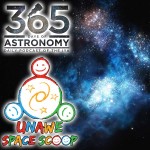Podcaster: Richard Drumm
 Title: Space Scoop: The First Stars in the Universe
Title: Space Scoop: The First Stars in the Universe
Organization: 365 Days Of Astronomy
Link : astrosphere.org ; http://unawe.org/kids/unawe1529/
Description: Space scoop, news for children.
Bio: Richard Drumm is President of the Charlottesville Astronomical Society and President of 3D – Drumm Digital Design, a video production company with clients such as Kodak, Xerox and GlaxoSmithKline Pharmaceuticals. He was an observer with the UVa Parallax Program at McCormick Observatory in 1981 & 1982. He has found that his greatest passion in life is public outreach astronomy and he pursues it at every opportunity.
Today’s sponsor: This episode of “365 Days of Astronomy” is sponsored by — no one. We still need sponsors for many days in 2015, so please consider sponsoring a day or two. Just click on the “Donate” button on the lower left side of this webpage, or contact us at signup@365daysofastronomy.org.
Transcript:
This is 365 Days of Astronomy. Today we bring you a new episode in our Space Scoop series. This show is produced in collaboration with Universe Awareness, a program that strives to inspire every child with our wonderful cosmos.
Today’s story is…
The First Stars in the Universe
The Big Bang that gave birth to our Universe was a spectacular event, an explosion that was unbelievably loud and bright. But the birth of our Universe had it’s quiet times too.
For a long stretch of time after its birth, our Universe was totally dark, silent and empty. The first stars didn’t spark into existence until the Universe was perhaps 100 million years old. At this time nothing existed in the Universe but gases and radiation.
The first stars to exist in our Universe have never been seen because they went extinct a long time ago. But that doesn’t stop us astronomers from talking about ’em! These stars would have been born out of the original matter created by the Big Bang.
The only matter that existed before the stars was hydrogen, helium and a tiny bit of lithium and beryllium. There was no element heavier than those. No carbon, oxygen, silicon or iron. This means that the first stars must have been made only out of these few elements, unlike the Sun and all the other stars now in our galaxy.
Using the time-traveling powers of light, astronomers have been in search of the first stars by closely examining the distant Universe, where the light started its journey when the Universe was much younger. And they’ve just spotted a number of amazingly bright and very young galaxies!
One of these galaxies in particular has scientists excited, it’s called CR7 and it’s in the constellation Sextans. CR7 is the brightest galaxy ever seen in the early Universe, and it was discovered using the ESO’s VLT, the Very Large Telescope at the Paranal Observatory in Chile. The scientists also used the Keck, Subaru and Hubble telescopes to study the distant galaxy.
You can see an artist’s painting of the galaxy in the picture in today’s album artwork. The clumps of what looks like fairy dust in the picture are indeed magical – they illustrate that this galaxy was home to some of the Universe’s very first stars!
These are the stars that formed the first heavy elements that eventually allowed us to be here. They are called Population III stars, and the current batch of stars we see around us are Population I and Population II. Don’t get too confused, though, the backward naming convention is purely accidental.
Pop I & II stars were simply the first to be officially categorized, in work done by astronomer Walter Baade of Mount Wilson Observatory in 1944. Pop I stars are the typical, ordinary ones we see at night all around us. Pop II stars are usually found in globular clusters and are the oldest stars we see today. Pop III stars, the oldest, were only theorized in a model of the Universe put forth by Martin Rees in 1978. Now it appears they’ve finally been found!
Hey, Here’s a Cool Fact
These first stars would have been enormous — several hundred or even a thousand times more massive than the Sun! And I thought I was overweight!
Thank you for listening to 365 Days of Astronomy!
End of podcast:
365 Days of Astronomy
=====================
The 365 Days of Astronomy Podcast is produced by NUCLIO. Audio post-production by Richard Drumm. Bandwidth donated by libsyn.com and wizzard media. You may reproduce and distribute this audio for non-commercial purposes. Please consider supporting the podcast with a few dollars (or Euros!). Visit us on the web at 365DaysOfAstronomy.org or email us at info@365DaysOfAstronomy.org. This year we celebrate cosmic light as light is our info messenger in the universe. Join us and share your story to celebrate the International Year of Light. Until tomorrow! Goodbye!

